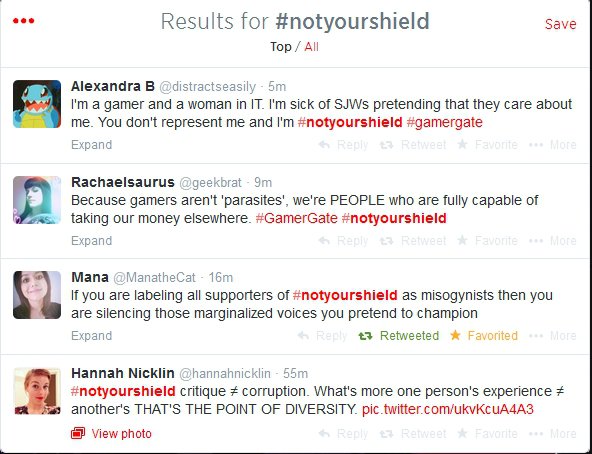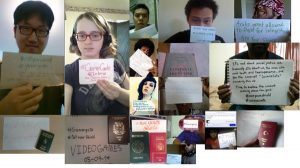
A sampling of Tweets showcasing the brief but troubling #NotYourShield campaign.
By Shane Snyder
Introduction: A Glaring Omission
Two months into my Fall 2020 composition course, “Possibility Spaces and Rhetoric in Video Games,” I realized something was wrong. Within sixteen weeks, I had scheduled only one lesson on the LGBTQ+ video game narratives Gone Home and Dys4ia, two discussions about predatory corporate capitalism and environmental destruction in The McDonald’s Videogame, and one week on violence and nationalism in Undertale. Most of the course content treated representation and culture as mere footnotes in an industry whose stories, environmental designs, and advertising culture tend to exclude all but able-bodied white men and boys. My oversight was problematic for two reasons. I am a new media, feminism, and American racism scholar specializing in the study of digital racism and misogyny in social media interfaces, video games, and politically far–right gamer communities. But the three weeks of social justice content I built into my course had treated identity, social inequality, and resistance as discrete problems instead of interconnected social phenomena. In sidelining the central research questions that should have animated the course, I had unwittingly designed a colorblind curriculum. As David J. Leonard explained in 2006 at a nexus in video game studies,
Excluding race (and intersections with gender, nation, and sexuality) from public discussions through erasure and acceptance of larger discourses of colorblindness contributes to problematic, if not faulty, understandings of video games and their significant role in contemporary social, political, economic, and cultural organization (84).
How was I to fix this problem? How could I design a writing and communication curriculum that better addressed the intersections of race, gender, class, nation, and disability? What would the course look like?
I promised to do better. The result is this Spring 2021 semester’s course, “Identity, Resistance, and Social Change in Video Games,” which draws its inspiration from the racist and misogynistic Twitter disinformation campaign #NotYourShield. The brainchild of GamerGate—a politically far–right movement stemming from harassment against women in the video games industry—#NotYourShield recruited nonwhite, non-cis-, LGBTQ+, and non–binary people (otherwise targets of GamerGate’s ire) to distort the language of anti-racist feminism, discredit social justice work, and push the American public further right. Over the last two months, my students have played and analyzed video games and read articles and book chapters whose stories and arguments resist the bitter rhetoric and hateful ideologies GamerGate and #NotYourShield promoted. They applied what they learned about GamerGate, #NotYourShield, and video game audiences to an assignment inspired by feminist ethnographic methods. They were to “enter, live in, and observe” a non-GamerGate online video gamer community of their choosing.
GamerGate and #NotYourShield framed our semester-long discussion about video game audiences because the movements both evoke strong emotions in those who encounter them and represent the American cultural work left to be done. I intended ethnography to act as the antithesis of GamerGate and #NotYourShield’s willful obfuscations and reductions. At its core, GamerGate is a movement about suppressing empathy and understanding. Ethnography, by contrast, is about setting aside pretensions of foreknowledge and instead prioritizing empathy and understanding. In other words, ethnography should provoke confusion, curiosity, and intellectual questions. I expected my students’ ethnographic projects collectively would paint a complex, contradictory, and surprising portrait of the audiences that build community around games.
Confronting the Manosphere
The bad publicity GamerGate received in 2014 for its coordinated harassment of feminist game designer, writer, and activist Zoe Quinn gifted the movement free advertising. GamerGate seized the opportunity. Refocusing American race and gender through the lens of a far-right political ideology, they argued that anti-racist feminism had no place in video games or American culture. What really mattered were their color- and gender-blind game consumer identities, which they believed had been called into question by an army of social justice totalitarians, some of whom spread their propaganda over social media, while the rest cloistered themselves in the hallowed walls of academia (Chess and Shaw 213).

Figure 1: A collage of images that show #NotYourShield participants announcing their support for GamerGate.
To build membership, they developed #NotYourShield to recruit people from the fringes. The campaign was a paradox. NotYourShield rebranded the movement as inclusive while attempting to conceal its white patriarchal discourses of exclusion. Started by a Black GamerGate proponent on 4Chan’s video games message board, #NotYourShield was ostensibly a coordinated effort by pro-GamerGate nonwhite, non-cis-, LGBTQ+, and non–binary people to express their antipathy toward diversity and inclusion in the video games industry (Mortensen 10). Participants snapped and publicized selfies in which they held signs with handwritten text that described their social identity and announced their support for GamerGate.
Some activists made fake Twitter accounts—a deceptive online practice known as sock puppeting—to promote their campaign. These fake accounts used stereotyped, racist language and stolen images of nonwhite people to create the illusion of support where there was little. While the campaign has long since fizzled out, its momentary success lay in its clever combination of authentic visual evidence (those holding the signs, or social media imagery) and carefully curated disinformation. The ironic racism and exclusionary politics of the campaign—the contention that individuals can act as representatives for entire marginalized groups—was lost on those whose minds were made up. The campaign had already substituted rugged individualism for systemic injustice.

Figure 2: In late 2014, GamerGate activists created this sock puppet account that lifted professor and anti-racist Christian activist Drew G. I. Hart’s image to support the movement. Note the #notyourshield in the profile description. These accounts generally have few followers and post only about a single subject.
I introduced this information to students in recorded lectures, readings, and biweekly synchronous sessions. Meanwhile, to broaden their conception of gamer audiences—what Adrienne Shaw calls the non-constructed (i.e., non-cis, non-white, and non-male) audience—students played Celeste, an experimental narrative platformer about a young transgender woman climbing a mountain to alleviate her anxieties, and Quinn’s Twine-made Depression Quest. Additionally, they analyzed racist and sexist depictions of Black men as criminals and women as expendable sex workers in the mainstream game Grand Theft Auto 5. The lesson taught that radical games—usually so-called “indie” games—like their subjects, are marginalized, while big–budget, studio-produced games inculcate ideologies GamerGate attempts to popularize. During synchronous sessions students voiced frustrations with the video games industry for limiting its audiences, despite indie game developers’ call to expand. Through GamerGate, #NotYourShield, and video game texts students witnessed the consequences of what feminist games scholar Kishonna Gray calls “the response of the default [white and male] gamer being forced to accept the inclusion of women and increased diversity in video games.” The anger they witnessed and the consequent anger they felt stem largely from “men’s anxieties over losing ground in a once homogeneous universe” (2)
Online Ethnography as Feminist Praxis
GamerGate still flourishes online. Its continued existence on social media (notably /r/KotakuInAction) highlights video gaming’s ascendance as a sociopolitical barometer. GamerGate’s abuse of power and its attempt to redraw the boundaries around anti-racist feminism taught students that video games extend into the real world of both online and offline life. As T.L. Taylor observes, online and offline life are neither synonymous nor separate. Rather, “people can slip into and out of complex social networks that cross not only online and offline space, but genres within the online world” (Taylor 19).
Designing an ethnography assignment seemed a logical extension of this lesson. I reasoned that my majority STEM students, whose disciplines privilege rigidly objective research methods, would benefit by learning a critically underexplored form of emergent social science research that demands their self-awareness as researchers. Borrowing from Donna Haraway’s twin notions of situated knowledges and feminist objectivity, the assignment asks students to live in an online video gamer community and observe members’ cultural practices. As Haraway describes it, feminist objectivity “is about limited location and situated knowledge, not about transcendence and splitting of subject and object. It allows us to become answerable for what we learn how to see” (583). Haraway’s point is that the researcher cannot presume to occupy a godlike vantage over their subjects. Instead, the researcher adopts a partial perspective, seeks out and documents community members’ points of view, and makes sense of what emerges out of the data.
Navigating Student Confusions
While designing the assignment sheet and breaking students into research pairs and trios, I feared the demands would overwhelm early-career college students with obscure, graduate-level research methods that entailed complex coding and data collection. I simplified the project guidelines and designed small, scaffolded assignments to narrow students’ focus and encourage their honesty as researchers. They began with a proposal in which they identified a gamer community, explained their logic for choosing it, and drafted two preliminary research questions. After the proposal stage, they wrote a document collecting descriptive facts about their communities, followed by field notes elaborating on their biases and preconceptions. The final report contained an introduction ending with a finalized research question, a methods section, data analysis portion, and an appendix exhibiting data collection samples (e.g., spreadsheets, screen captures of social media data, etc.). Half of my students chose to explore toxicity, a convention in online gaming where disruptive trolls threaten, harass, or hurl hate speech at other players. The rest divided their projects between labor practices in video game speedrunning (i.e., beating a game as fast as possible), the sexist treatment of female Twitch streamers, and the incongruously warm reception of aggressive or toxic male streamers.
As expected, the research questions needed tinkering. In Discord community discussions and remote meetings, we workshopped the questions until they were broad, open-ended, and non-judgmental. Some students found this counterintuitive, for two reasons. Their first large project—a multimodal research paper—demanded narrow research questions whose answers fit into no more than eight pages. Broadening those questions for a smaller word count, they reasoned, taught the opposite lesson. The other objection had to do with what they interpreted as the tone of the class. Some students wondered why they should avoid leading questions in a course that openly castigates problematic communities. To the first objection, I argued questions like “why is this community so toxic?” and “how does this community justify its continued support of a cheater?” contained too many built-in assumptions. What if the community uniquely defines “toxic”? What if they don’t believe the streamer cheated? What if the community doesn’t try to justify it? And if they do believe it, what if they don’t care? To the second objection, I explained that their field notes will allow them to speak their mind with reckless abandon. And anyway, the course’s GamerGate material summarized findings from my own, years-long research. The community had already explained themselves.
Ethnography is About Ethics
My point was that, even without IRB approval, interviews, or surveys, ethnography requires that we, as researchers, constantly consider the ethical situation. How we frame these communities, and from what position, invariably informs how we write, what we write about, and what we allow ourselves to see. For budding scientists and engineers who, I fear, are trained to see through an essentializing lens of pure, unemotional objectivity, this is profoundly important. Our students will inevitably encounter political and personal obstacles as well as ethical problems unique to their disciplines. Since ethnography arises from living communities whose values and practices constantly evolve, it is an ideal space to encourage these self-reflections in early-career undergraduates.
Good ethics also entails letting data emerge, as opposed to mapping our preconceptions onto that data. That pure objectivity is an illusion means this is impossible to do perfectly. However, it is in our best interests, as researchers, teachers, and citizens, to inventory our biases and approach social and cultural spaces with sensitivity and care. Tom Boellstorff, et al. argue that “ethnography centers on discovery and interpretation. Its questions are formulated to address broad problems of social and cultural life” (31). Narrow, targeted, closed-off questions undermine such a mission, as they risk presupposing an absolute truth and obscuring surprises. Contradictions, internal politics, and strife over what to outsiders seems trivial are some communities’ lifeblood. Who are we to suppose otherwise?
Once students realized their research questions shape how they see and write about their communities, they revised their language. This small ethnographic assignment taught that ethical self-positioning, understanding, and open-mindedness constitute subversive acts of empathy that, by their very nature, resist the grandstanding, individualistic sexism and racism of GamerGate and #NotYourShield. Open-mindedness and understanding do not mean entertaining terrible ideas. They mean becoming ethical researchers who let patterns and stories emerge. The data speaks and the researcher transcribes. In other words, the community provides the mirror, and the researcher reflects the image back. There is a lot of power in that relationship. And so, we must teach our students to be careful and methodical. Careful to understand. Careful in what they see and write about. That carefulness is a radical act of empathy.
